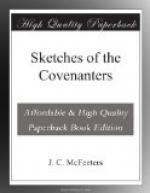The General Assembly had fallen into a state of bitter strife—the snare of Satan. There were two parties and these were quite well balanced. Their power for good was greatly neutralized by one another; their influence for harm was incalculable; the baneful effect spread like a withering shadow over the land. The two parties, at the beginning, chiefly differed in the methods employed to accomplish the same end. The one was governed by expediency; the other by principle. Expediency drew the majority; principle held the remainder. The majority discounted the obligations of the Covenant; the minority held to the spirit and letter of the sacred bond. The party in power precipitated the direful conditions. This they did by repeated breaches of the Covenant. The responsibility for the disgraceful proceedings, and the shameful termination of the Assembly, must be attached to these who made the discussion a moral necessity.
The first shadow that darkened the General Assembly was the discussion of “The Engagement.” Two unscrupulous men—one of them a Covenanter—had made a secret engagement with Charles I. in his captivity. They had promised to seat him, if possible, again on his throne; he in turn had engaged to favor Presbyterianism three years. The Engagement aroused earnest and violent discussion in the Assembly. The element of strife had now entered the Supreme Court of God’s House, and the downward trend was deplorably rapid.
The next vexation was the abolition of “The Act of Classes.” The Act of Classes guarded all places of trust in the government and army. None but those who expressed sympathy with the National Covenant were eligible to places of trust. Here was an unparalleled state of civil affairs; the world had never seen the like. This was a marvelous stride toward the Millennium. The fathers are worthy of all praise for this unprecedented effort to build the national government upon the true foundation of God’s will, and administer it by men in Covenant with Jesus Christ, the king of kings. This was the first attempt to erect a Christian government, in which the fear of God should pervade every department and characterize every official. The abolition of the Act of Classes involved a great moral issue which the General Assembly had to meet. Strangely, the Assembly was divided in the discussion; the debate waxed vehement and bitterly passionate. The majority favored abolition, thus opening the flood-gates of moral laxity in official stations. These were called “Resolutioners”, because they offered the resolution to this effect, and supported it: the minority were called “Protesters”, because they protested against it.
[Illustration: King Charles II.
King Charles II. ascended the throne in 1651, but was soon defeated and driven from the country by Oliver Cromwell. In 1660 his kingdom and power were restored and he reigned till 1685. His death was sudden and mysterious, poisoning by his brother, the Duke of York, having been suspected. He died at the age of fifty-five. He was called the “Merry Monarch,” though his reign was characterized by atrocious cruelty. Under him the persecution waxed so violent that some of these years were called “The Killing Times.”]




